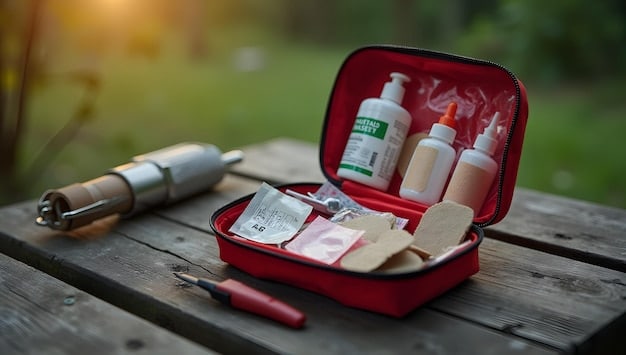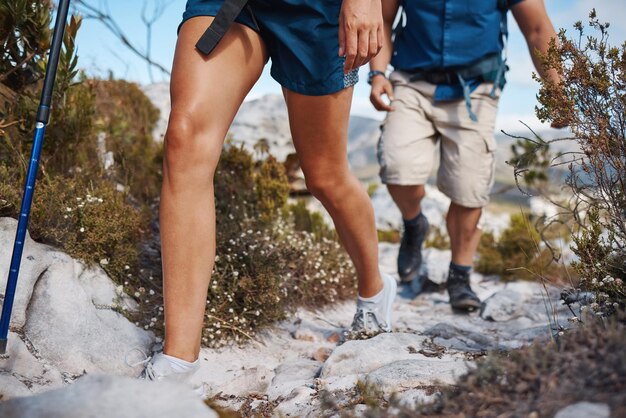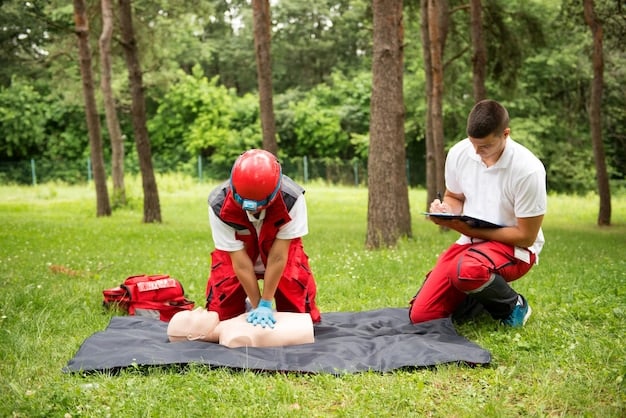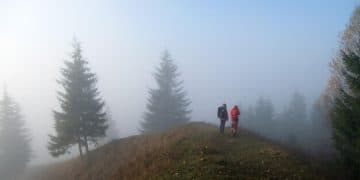National Park First Aid: Skills & Supplies for Wilderness Emergencies

National Park First Aid: Essential Skills and Supplies for Wilderness Emergencies equips adventurers with crucial knowledge and tools for handling medical situations in remote settings, ensuring preparedness and safety during outdoor explorations.
Embarking on an adventure in a national park is an exhilarating experience, but it also requires careful preparation, especially when it comes to safety. Understanding national park first aid: essential skills and supplies for wilderness emergencies is paramount. This guide will equip you with the knowledge and resources needed to handle unexpected medical situations, ensuring your journey is as safe as it is memorable.
Why National Park First Aid is Crucial
Venturing into a national park means immersing yourself in nature’s raw beauty. However, these remote locations present unique challenges. Help is often far away, making immediate first aid critical. Understanding potential risks and knowing how to respond can significantly impact the outcome of an emergency.
Remote Location Challenges
National parks are often located far from medical facilities. This isolation can delay professional medical assistance, making on-site first aid a necessity. Time is of the essence in emergency situations, and being prepared can save lives.
Potential Risks in National Parks
National parks are home to diverse landscapes, each with its own set of risks. From wildlife encounters to rugged terrains, understanding these hazards is vital for preventing accidents. Common injuries include sprains, fractures, cuts, burns, and allergic reactions.
- Wildlife Encounters: Knowing how to respond to animal encounters can prevent injuries.
- Terrain Challenges: Uneven trails and steep inclines can lead to falls and sprains.
- Weather Conditions: Extreme weather can cause heatstroke, hypothermia, or dehydration.
Having a well-stocked first aid kit and knowing how to use it can bridge the gap until professional help arrives. This preparation empowers you to handle minor injuries and stabilize more serious conditions.

Building Your Essential National Park First Aid Kit
A well-equipped first aid kit is your first line of defense in a national park. It should be customized to the specific risks of your planned activities and the number of people in your group. Prioritize essential items and ensure everything is organized and easily accessible.
Core Components of a First Aid Kit
Every first aid kit should include basic supplies to address common injuries. These components are essential for immediate care and can help prevent complications.
- Bandages and Gauze: For wound care and protection.
- Antiseptic Wipes: To clean wounds and prevent infection.
- Pain Relievers: Over-the-counter medications for pain management.
- CPR Mask: For safe administration of rescue breaths.
Customizing Your Kit
Consider the specific risks of your planned activities. If you’re hiking, include blister treatment and supplies for sprains. If you’re camping, add insect repellent and burn cream. Tailor your kit to your individual needs and the environment.
Water purification tablets are crucial for ensuring a safe drinking supply, reducing the risk of waterborne illnesses in remote areas. Additionally, including any personal medications can be lifesaving.
Essential First Aid Skills for National Parks
Having the right supplies is only half the battle. Knowing how to use them effectively is crucial for handling medical emergencies. Acquiring basic first aid skills can empower you to provide life-saving care until professional help arrives.
Basic Wound Care
Proper wound care can prevent infection and promote healing. Clean the wound thoroughly with antiseptic wipes, apply antibiotic ointment, and cover with a sterile bandage. Replace bandages regularly to keep the wound clean.
Treating Sprains and Fractures
Sprains and fractures are common injuries in national parks. Immobilize the injured limb with a splint, apply ice to reduce swelling, and elevate the limb to promote circulation. Seek professional medical attention as soon as possible.
Managing Allergic Reactions
Allergic reactions can range from mild to severe. Recognize the signs of anaphylaxis, such as difficulty breathing, swelling of the face or throat, and dizziness. Administer epinephrine (EpiPen) if available and call for emergency medical assistance.
Consider taking a wilderness first aid course to gain hands-on experience in managing these and other common injuries. Proper training can provide you with the confidence and skills needed to respond effectively in an emergency.

Dealing with Common Wilderness Emergencies
National parks present a unique set of challenges that require specific first aid knowledge. Understanding how to manage common wilderness emergencies such as heatstroke, hypothermia, and dehydration is essential for ensuring your safety.
Heatstroke and Hypothermia
Heatstroke and hypothermia are serious conditions caused by extreme temperatures. Recognize the symptoms of each condition and take immediate action. For heatstroke, move the person to a cool place, remove excess clothing, and apply cool water. For hypothermia, warm the person gradually with blankets and warm drinks.
Dehydration and Waterborne Illnesses
Dehydration is a common risk in arid environments. Drink plenty of water throughout the day, even if you don’t feel thirsty. Waterborne illnesses can be prevented by purifying water before drinking it. Use a water filter or purification tablets to kill harmful bacteria and viruses.
- Heatstroke Symptoms: High body temperature, confusion, rapid pulse.
- Hypothermia Symptoms: Shivering, confusion, slow breathing.
- Preventing Dehydration: Drink water regularly, even when not thirsty.
Being aware of these common wilderness emergencies and knowing how to respond can significantly improve your chances of a positive outcome. Plan your trips accordingly, considering the environment and weather conditions.
Preventative Measures: Staying Safe in National Parks
Prevention is always better than cure. Taking preventative measures can significantly reduce your risk of injury or illness in a national park. Proper planning, preparation, and awareness can help you stay safe and enjoy your adventure.
Planning and Preparation
Thoroughly research your destination before you go. Understand the potential risks and hazards, and plan your activities accordingly. Inform someone of your itinerary and expected return time. Pack appropriate clothing, gear, and supplies for the environment and weather conditions.
Awareness and Vigilance
Be aware of your surroundings at all times. Pay attention to weather conditions, terrain, and wildlife. Avoid taking unnecessary risks and follow park guidelines and regulations. Stay on marked trails and avoid venturing into hazardous areas.
- Check Weather Forecasts: Be prepared for changing conditions.
- Stay on Marked Trails: Avoid getting lost or injured in unfamiliar terrain.
- Wildlife Safety: Maintain a safe distance from animals and store food properly.
By prioritizing safety and taking preventative measures, you can minimize your risk of injury or illness and ensure a safe and enjoyable national park adventure. Remember to respect the environment and leave no trace behind.
Using Technology for National Park Safety
Technology can be a valuable tool for enhancing safety in national parks. GPS devices, satellite communicators, and smartphone apps can provide navigation, communication, and access to important information in remote locations.
GPS Devices and Navigation
GPS devices can help you navigate unfamiliar terrain and stay on course. Download maps of your destination before you go, and learn how to use the device effectively. Carry extra batteries, as GPS devices can drain quickly in the backcountry.
Satellite Communicators
Satellite communicators allow you to send and receive messages, even when you’re out of cell phone range. These devices can be used to call for help in an emergency or to check in with loved ones. Consider investing in a satellite communicator for your next national park adventure.
Smartphone Apps and Resources
Many smartphone apps provide valuable safety information, such as trail maps, weather forecasts, and wildlife alerts. Download these apps before you go, and familiarize yourself with their features. Be aware that cell phone service may be limited or unavailable in some areas.
Utilize technology to enhance your safety, but don’t rely on it entirely. Always carry traditional navigation tools, such as a map and compass, and learn how to use them effectively.
| Key Point | Brief Description |
|---|---|
| 🎒 Essential First Aid Kit | A well-stocked kit is crucial for immediate care in remote areas. |
| 🩹 Basic First Aid Skills | Knowing how to treat wounds and sprains can prevent complications. |
| 🌡️ Wilderness Emergencies | Manage heatstroke, hypothermia, and dehydration effectively. |
| 📱 Technology for Safety | Use GPS, satellite communicators, and smartphone apps wisely. |
Frequently Asked Questions
▼
Your kit should include bandages, antiseptic wipes, pain relievers, a CPR mask, blister treatment, insect repellent, burn cream, water purification tablets, and any personal medications.
▼
Stay hydrated by drinking plenty of water, wear light-colored and loose-fitting clothing, avoid strenuous activities during the hottest part of the day, and seek shade whenever possible.
▼
Signs include difficulty breathing, swelling of the face or throat, and dizziness. Administer epinephrine (EpiPen) if available and call for emergency medical assistance immediately.
▼
Use a water filter or purification tablets to kill harmful bacteria and viruses. Boil water for at least one minute as an alternative method if you do not have access to a filter or tablets.
▼
If you get lost or injured, someone will know where to look for you and can alert the authorities if you don’t return as expected. This significantly improves your chances of being found quickly.
Conclusion
Preparing for potential medical emergencies is an integral part of any national park adventure. By equipping yourself with the essential first aid skills and supplies outlined in this guide, you can confidently explore the wilderness, knowing you’re well-prepared to handle unexpected situations. Remember, safety should always be a top priority, ensuring that your national park experience is both memorable and secure.





